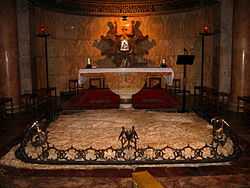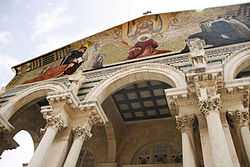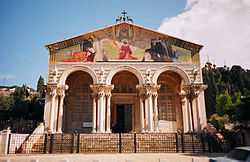Church of All Nations
| Church of All Nations | |
|---|---|
|
Church Facade | |
| Basic information | |
| Location | Jerusalem |
| Affiliation | Roman Catholic |
| Year consecrated | May 1924 |
| Ecclesiastical or organizational status | Minor Basilica |
| Architectural description | |
| Architect(s) | Antonio Barluzzi |
| Architectural style | Byzantine |
| Completed | 1924 |

The Church of All Nations, also known as the Church or Basilica of the Agony, is a Roman Catholic church located on the Mount of Olives in Jerusalem, next to the Garden of Gethsemane. It enshrines a section of bedrock where Jesus is said to have prayed before his arrest. (Mark 14:32-42)
History
The current church rests on the foundations of two earlier ones, that of a small 12th century Crusader chapel abandoned in 1345, and a 4th-century Byzantine basilica, destroyed by an earthquake in 746. In 1920, during work on the foundations, a column was found two meters beneath the floor of the medieval crusader chapel. Fragments of a magnificent mosaic were also found. Following this discovery the architect immediately removed the new foundations and began excavations of the earlier church. After the remains of the Byzantine era church were fully excavated plans for the new church were altered and work continued on the current basilica from April 19, 1922 until June 1924 when it was consecrated.
Use by other denominations

An open altar located in the gardens of the church is used by many Christian denominations including followers who are Roman Catholic, Eastern Orthodox, Armenian Apostolic, Protestant, Lutheran, Evangelical, Anglican, and any other version of Christianity or Orthodoxy that is culturally unique to any particular nation.
Design and construction
The chapel was built between 1919 and 1924 using funds donated from many different countries. The respective coat-of-arms of each donating country are incorporated into the glass of the ceiling, each in a separate, small dome, and also into the interior mosaics. The countries honored in this way are; starting from the left side, beginning with the apse: Argentina, Brazil, Chile and Mexico; in the middle of the church are commemorated: Italy, France, Spain and the United Kingdom, and to the right: Belgium, Canada, Germany, and the United States of America. The mosaics in the apses were donated by Ireland, Hungary, and Poland. The crown around the bedrock itself was a gift of Australia. These multi-national donations give the church its present title as the Church of "All Nations".
Two types of stone were used in the construction of the church: the interior utilizes a stone from the quarries at Lifta, north-west of Jerusalem; and the exterior, a rose colored stone from Bethlehem. The building is divided by six columns into three aisles. This design gives the impression of one large open hall. Violet-colored glass was used throughout the church to evoke a mood of depression analogous to Christ's agony, and the ceiling is painted a deep blue to simulate a night sky.
The facade of the church is supported by a row of Corinthian columns set below a modern mosaic depicting Jesus Christ as mediator between God and man. The designer of the facade mosaic was Professor Giulio Bargellini. The bubble-domed roof, thick columns, and facade mosaic, give the church a Classical look architecturally.
The church was designed by Italian architect Antonio Barluzzi and is currently held in trust by the Franciscan Custody of the Holy Land.
Picture Gallery
-

Nave and vault
-
Left aisle
-
Central aisle
-
Interior view towards main door
-

Night view
-
.jpg)
Front view
References
- Basilica of the Agony (Israeli Ministry of Foreign Affairs website)
External links
| Wikimedia Commons has media related to Church of All Nations (Jerusalem). |
- Virtual Tour inside the church Taken at December 2007
- Virtual Tour outside of the church Taken at December 2007
- Virtual Tour of Jerusalem @ jerusalem360.com - Interactive Panoramas from Israel
- Mount of Olives - Churches on Mount of Olives. Photos and general information.
- Jerusalem Photo Archive - Christian Quarter
- The Franciscan Custody of the Holy Land
Coordinates: 31°46′45″N 35°14′23″E / 31.779227°N 35.239628°E



